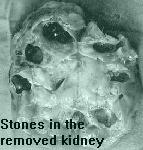

![]()
I couldn’t but help observe and express my surprise to the consultant surgeon that an organ which took all of nine months to grow and form in the mother’s womb took all of twenty minutes in the surgeon’s skilled hands to be removed.
She was a forty-four-year-old woman from Moratuwa, a widow with two daughters, the youngest just turned twenty two. She had a history of kidney stone for which she underwent surgery in 1993. The scar could still be seen.
Until two months ago she was keeping well until she experienced, she said, abdominal pains on the right side and backache, UTI or better known as Urinary Tract Infection in kidney, blood in the urine and collection of pus.
The x-ray films showed that her right kidney was virtually choked with stones and was enlarged and blocked her urethra.
The surgeon explained that one need not operate for stones always. By shock wave-called extra corporeal shock wave lithotripvy - with instruments introduced through the kidney or bladder the stones can be got rid of.
But our patient’s kidney had to be removed, as it was in an advanced stage of infection and enlarged.
The patient was wheeled into the theatre and the operating table lowered and tilted and the patient made to lie with her right side up, as this was where the incision was to be made.
Her right arm across her chest was strapped as were her legs.
The chief anaesthetist gave her general anaesthesia and clamped an oxygen cap on her nose. The surgeon made his incision in the loin and had to cut through the fat and the muscle to reach the affected kidney.
The assistant surgeon applied a retraction to enable the chief surgeon to have easy unhindered access to the kidney. The surgeon had to reach the artery and the vein supplying blood to the kidney and then clamp them.
The kidney was next taken out and the artery vein and urethra tied. Bleeding was controlled by the use of the ‘diathermy probe’ and the wound like a gaping maw was closed layer by layer. A suction tube was attached to the kidney to remove any blood out.
The surgeon sutured with catgut in a neat cross-stitch holding a needle holder to which is fixed the special needle and a pair of forceps to help. "Do you think this stitching is as good as that of the machine stitch ?," asked the relaxed surgeon.
 The
kidney, enlarged and bean shaped, had within it over ten stones. They were of
various sizes and shapes and usually contain about eight to ninety percent of
calcium.
The
kidney, enlarged and bean shaped, had within it over ten stones. They were of
various sizes and shapes and usually contain about eight to ninety percent of
calcium.
"You can hand over the stones to a jeweller and make a necklace,’’ he said. The patient now with only one kidney which the surgeon said "is more than enough for survival’’ was carefully tilted into a stretcher and taken away. She can walk about in about three days and go home after a week.
The surgical team at the Jayewardenepura Hospital calls for my admiration. They are very helpful, especially the chief anaesthetist who even gave me a booklet written by her colleague Dr. Suriyakanthie Amarasekera on ‘‘Learning Again to Care.’’
The Sunday Times thanks the Management of Sri Jayewardenepura Hospital and the unassuming chief surgeon Dr. Gamini Goo-netilleke.
Continue to Plus page 5 - They were locked together kissing
Return to the Plus contents page
![]()
| HOME PAGE | FRONT PAGE | EDITORIAL/OPINION | NEWS / COMMENT | BUSINESS
Please send your comments and suggestions on this web site to
info@suntimes.is.lk or to
webmaster@infolabs.is.lk